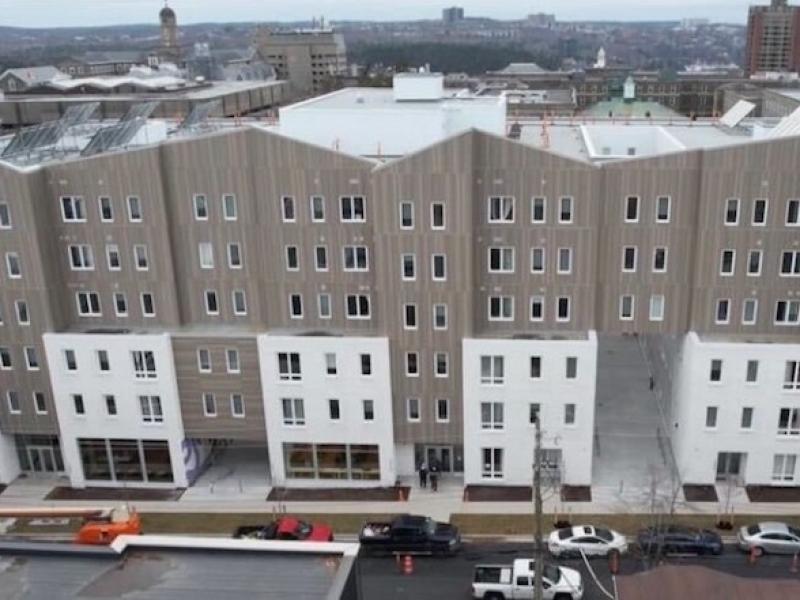A lack of purpose-built student accommodations (PBSA) is contributing to Canada’s housing shortage and near-term prospects for future students are unlikely to improve.
BONARD — a Vienna-based provider of independent data, research and advisory for the rented residential sector — released a report titled Why Canada’s PBSA sector is a great opportunity for investors earlier this year.
RENX spoke with BONARD’s real estate business development director Martin Varga for an article about the report in May and Varga recently outlined the newest findings before moderating an online discussion involving key Canadian players on the need for more PBSA in Canada.
BONARD looked at 24 Canadian cities with 192 universities and colleges as well as 856 PBSA assets with 165,762 beds in its latest research.
An overview of PBSA in Canada
Canada had 2.21 million university and college students, including 444,860 international students, at BONARD’s last count. The compound annual growth rate of international students in Canada from 2016-‘17 to 2021-’22 was 9.9 per cent, far outpacing the 1.2 per cent growth rate for domestic students.
Canada had a 10.3 per cent PBSA provision rate and a 15.7 per cent private PBSA provision rate, much lower than most European countries. The United Kingdom, for example, had a 27 per cent provision rate and a 60.6 per cent private provision rate for 2.86 million students.
Off-campus PBSA stock in Canada is comprised of smaller residences than on-campus. Despite off-campus properties making up 42 per cent of total buildings, they contain only 29 per cent of beds.
The total PBSA provision rate ranges from a low of five per cent in Winnipeg and Quebec City to 35.6 per cent in Waterloo. The private PBSA provision rate ranges from zero in Victoria to 25.5 per cent in Waterloo.
The largest nine PBSA brands operate 51 per cent of off-campus beds, led by Canadian Student Living at 10 per cent, The MARQ at nine per cent and Canadian Campus Communities at seven per cent.
The 46 residences totalling 16,735 beds in the construction and planning pipeline won’t meet the needs of the underdeveloped PBSA market. Beds set to open by 2026 only add 0.5 per cent to total provision.
BONARD forecasts a PBSA provision rate of 12.7 per cent by the 2029-’30 school year.
Rents for both off- and on-campus PBSA are higher than in most European countries, a potential incentive to developers. There are major hurdles however, and panellists involved in the Nov. 2 webinar discussed the challenges.
UBC is a leader, but still falling behind
The University of British Columbia (UBC) operates 13,800 student beds on its Vancouver campus and more than 16,000 in the province, which makes it the largest system in Canada, according to associate vice-president of student housing and community services Andrew Parr.
UBC has added 5,500 new beds in the past 12 years and has still seen its wait list rise from 3,200 to over 8,000.
Parr said Canadian universities have traditionally seen housing as something that was nice to have, “as opposed to a responsibility and seeing it as a recruitment and retention opportunity.”
They would historically provide a housing guarantee for first-year students, then allow the marketplace to take over.
Parr said the rising number of international students, who pay higher tuitions and are more lucrative for universities than domestic students, has put pressure on the system because 70 per cent want to live on campus.
There have been few government programs associated with PBSA and Parr believes this must change.
Government red tape
“One of the main reasons we haven’t seen more development is just red tape,” said Slate Asset Management VP Veronica Green, who previously held senior roles in the Ontario Premier’s office and the federal office of the official opposition before joining Slate in 2020 to oversee mixed-use developments in Toronto, Mississauga and Hamilton.
Green said British and American universities have, for decades, “been able to control their campus expansions, land bank real estate, enhance their built environment, take on debt to finance new builds, own their retail and, of course, ultimately attract new students and grow . . .
“By sharp contrast, universities and colleges that received more than $10 million from the Government of Ontario are guided by that broader public sector procurement directive that mandates a really lengthy RFP (request for proposal) process for all construction and service contracts.
“What’s more, that university can’t take on new debt and their balance sheet rolls up to the province. That means it’s incredibly difficult for universities to build on-campus housing on their own.
“They’ve got to look to the private sector to support financing, development and construction.”
That process, she said, could take almost a decade.
Canada’s conservative lending environment
Canada has traditionally had a conservative lending environment where debt capital has gone toward more traditional real estate asset classes, but Green said increasing interest in PBSA may be turning the tide.

Harrison Street, a Chicago and London-headquartered global alternative asset management company, has about $56 billion US in assets under management.
Jonathan Turnbull, managing director of Harrison Street Canada, said the company is the second-largest owner of student housing in the U.S. Part of his mandate is to build a sizable PBSA portfolio in Canada.
“Every single day we look at it from an operating standpoint and it feels like the sector is proving itself,” said Turnbull, who agreed lenders haven’t traditionally shown much interest in student housing.
Turnbull said it’s perplexing why the largest defined benefit pension funds in Canada have increased their real estate exposure from $20 billion to $200 billion over the past 20 years but haven’t invested in PBSA, while major institutional investors in other countries have.
Global investors haven’t moved into the Canadian PBSA sector in a meaningful way because they don’t see historical performance, scale or a large company that has taken a lead they could follow.
London, Ont.-based Sandy Harrington, VP and managing director of real estate finance for CMLS Financial, has been involved with financing student properties and seen different cycles since the 1990s.
Harrington expects his firm to “close out over half-a-billion dollars of student housing” this year, but he acknowledged there’s still a wide gap between supply and demand.
“You’ve had some people that were pretty good at developing that have left and gone on to other asset classes because it was easier,” said Harrington, adding institutional and global investors have largely stayed away from PBSA because they didn’t see the scale to grow.
“Lenders need to see larger participants, of which there are some now, bringing quality assets to the market on a more consistent basis.”
Federal government needs to be more involved
Gonzalo Peralta is the executive director of Languages Canada, which represents public and private institutions teaching English and French to Canadian and international students.
Peralta believes Canada needs a federal ministry of education so issues, including student housing, don’t fall through the cracks.
“When we see students living in vans in parking lots, you know that there’s something seriously wrong and we need to address this,” Peralta said.
Green thinks continuous programs that promote high-density development and streamline bureaucratic processes should be implemented through the Canada Mortgage and Housing Corporation.
“You can fast-track applications straight to building permit and encourage construction of energy-efficient buildings,” she said.
“This would align with not just a developer’s own internal ESG (environmental, social and governance) framework, but the institutional expectations around takeout.
“Then you can encourage, at the municipal level, high-density zoning around universities. This is something that Oshawa and Waterloo have already made moves on.”
More public-private partnerships are needed
Turnbull said public-private partnerships will be critical in driving PBSA development. Parr agreed, but said: “It’s very challenging to build those relationships and look at investment opportunities because of the red tape and the moratoriums that are in place around borrowing.”
The B.C. government invested $450 million in student housing over the past six years to add 5,000 beds, according to Parr. It was so successful the government increased its investment by $1.1 billion.
Parr thinks other provinces should introduce similar programs because every international student who comes to Canada and doesn’t live in PBSA is taking space in a very tight rental market and exacerbating the overall housing crisis.
Almost half of the students residing in UBC’s campus housing are international, but it’s only accommodating 41 per cent of international students; about 10,000 live elsewhere in Vancouver.
Turnbull said if new, high-quality PBSA is built on or next to campuses, students will gravitate to it and free up older space for others. With 500,000 new immigrants coming to Canada annually over the next few years, that “shadow supply” will be at a premium.
The turnover rate in traditional multifamily housing in Canada is now below 10 per cent, as people aren’t moving as frequently as in the past. There’s still turnover in PBSA, however, because students move on after graduation.
“That’s going to be the biggest driver that’s going to be able to push the sector to outperform, to lower the risk profile and attract global capital,” Turnbull said.
“We’re excited about the space not only because of the natural growth in demand, but this absorption of supply that I think is going to be incredibly powerful.”









